2014 Peugeot 308 fuel consumption
[x] Cancel search: fuel consumptionPage 129 of 400
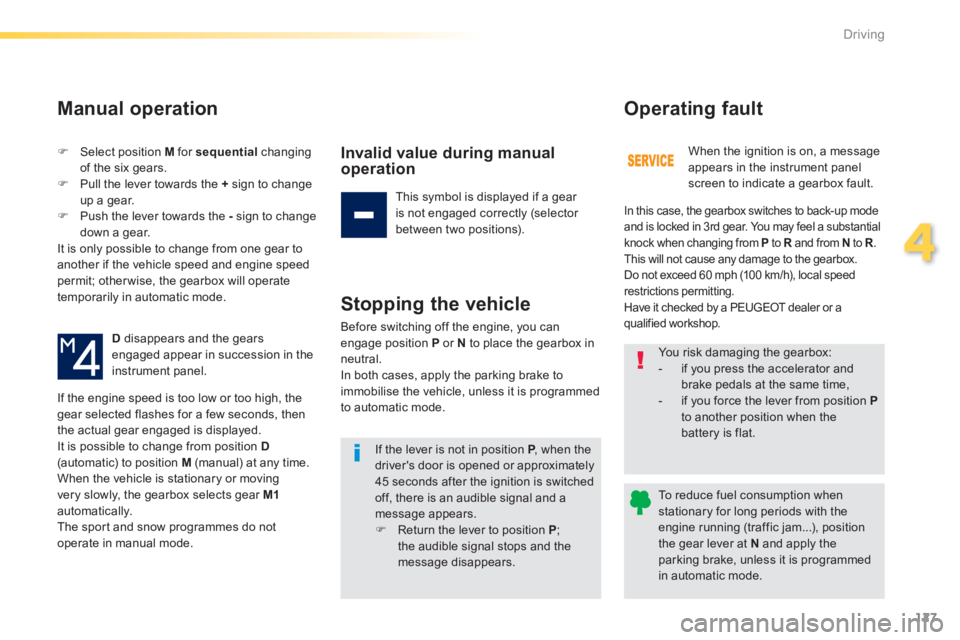
127
4
Driving
308_EN_CHAP04_CONDUITE_ED02-2013
Select position M for sequential changing of the six gears. Pull the lever towards the + sign to change up a gear. Push the lever towards the - sign to change down a gear. It is only possible to change from one gear to another if the vehicle speed and engine speed permit; otherwise, the gearbox will operate temporarily in automatic mode.
D disappears and the gears engaged appear in succession in the instrument panel.
If the engine speed is too low or too high, the gear selected flashes for a few seconds, then
the actual gear engaged is displayed. It is possible to change from position D(automatic) to position M (manual) at any time. When the vehicle is stationary or moving very slowly, the gearbox selects gear M1automatically. The sport and snow programmes do not operate in manual mode.
Manual operation
Invalid value during manual operation
This symbol is displayed if a gear is not engaged correctly (selector between two positions).
Stopping the vehicle
Before switching off the engine, you can engage position P or N to place the gearbox in neutral. In both cases, apply the parking brake to immobilise the vehicle, unless it is programmed
to automatic mode.
If the lever is not in position P , when the P , when the Pdriver's door is opened or approximately 45 seconds after the ignition is switched off, there is an audible signal and a message appears. Return the lever to position P ; the audible signal stops and the message disappears.
When the ignition is on, a message appears in the instrument panel screen to indicate a gearbox fault.
Operating fault
In this case, the gearbox switches to back-up mode and is locked in 3rd gear. You may feel a substantial knock when changing from P to R and from R and from RN to R . R . RThis will not cause any damage to the gearbox. Do not exceed 60 mph (100 km/h), local speed restrictions permitting. Have it checked by a PEUGEOT dealer or a qualified workshop.
You risk damaging the gearbox: - if you press the accelerator and brake pedals at the same time, - if you force the lever from position Pto another position when the battery is flat.
To reduce fuel consumption when stationary for long periods with the engine running (traffic jam...), position
the gear lever at N and apply the parking brake, unless it is programmed in automatic mode.
Page 131 of 400

129
4
Driving
308_EN_CHAP04_CONDUITE_ED02-2013
Stop & Start
Operation
Going into engine STOP mode
The "ECO" warning lamp comes on in the instrument panel and the engine goes into standby automatically:
- With a manual gearbox , at speeds below 12 mph (20 km/h) or vehicle stationary (depending on the engine), when you place the gear lever in neutral, and you release the clutch pedal.
Never refuel with the engine in STOP mode; you must switch off the ignition with the button.
For your comfort, during parking maoeuvres, STOP mode is not available for a few seconds after coming out of reverse gear. STOP mode does not affect the functionality of the vehicle, such as for example, braking, power steering...
Special cases: STOP mode not available
STOP mode is not invoked principally when: - the vehicle is on a steep slope (up or d ow n), - the driver's door is open, - the driver's seat belt is not fastened, - the vehicle has not exceeded 6 mph (10 km/h) since the last engine start by the driver, - the electric parking brake is applied or being applied, - the engine is needed to maintain a comfortable temperature in the passenger compartment,
- demisting is active, - some special conditions (battery charge, engine temperature, braking assistance, ambient temperature...) where the engine is needed to assure control of a system.
If your vehicle is fitted with Stop & Start, a time counter calculates the time spent in STOP mode during a journey.
In this case, the "ECO" warning lamp flashes for a few seconds then goes of f. This operation is perfectly normal.
The Stop & Start system puts the engine temporarily into standby - STOP mode - during stops in the traffic (red lights, traffic jams, or other...). The engine restarts automatically - START mode - as soon as you want to move off. The restart takes place instantly, quickly and silently. Per fect for urban use, the Stop & Start system reduces fuel consumption and exhaust emissions as well as the noise level when stationary.
Stop & Start time counter
(minutes / seconds or hours / minutes)
- With an automatic gearbox , vehicle stationary, when you press the brake pedal or place the gear selector lever in position N .
It resets to zero every time the ignition is switched on.
Page 191 of 400
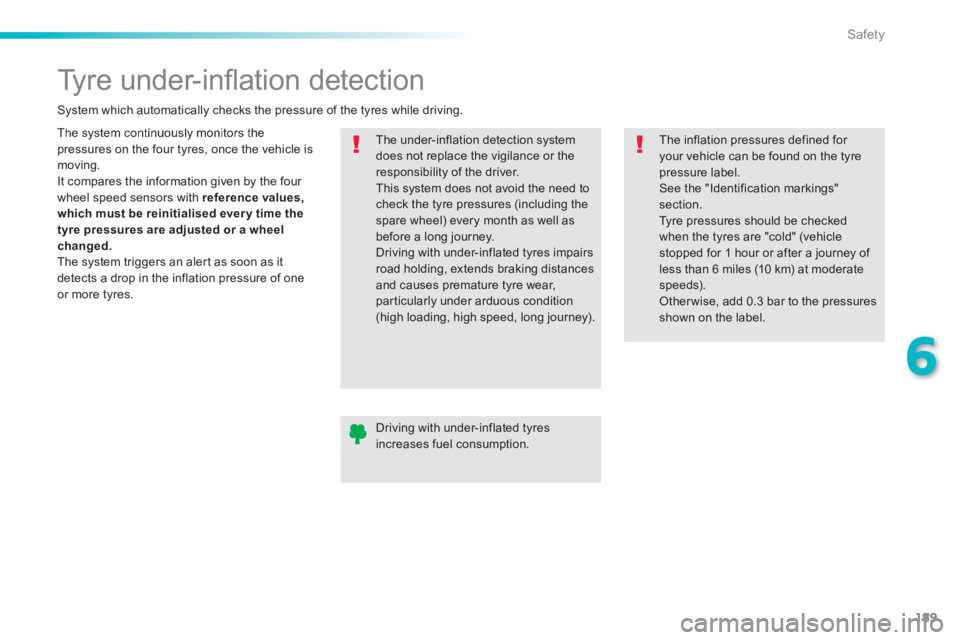
189
6
Safety
308_EN_CHAP06_SECURITE_ED02-2013
Tyre under-infl ation detection
The system continuously monitors the pressures on the four tyres, once the vehicle is moving. It compares the information given by the four wheel speed sensors with reference values, which must be reinitialised ever y time the tyre pressures are adjusted or a wheel changed. The system triggers an alert as soon as it detects a drop in the inflation pressure of one or more tyres.
The under-inflation detection system does not replace the vigilance or the responsibility of the driver. This system does not avoid the need to check the tyre pressures (including the spare wheel) every month as well as before a long journey. Driving with under-inflated tyres impairs road holding, extends braking distances and causes premature tyre wear, particularly under arduous condition (high loading, high speed, long journey).
System which automatically checks the pressure of the tyres while driving.
The inflation pressures defined for your vehicle can be found on the tyre pressure label. See the "Identification markings" section. Tyre pressures should be checked when the tyres are "cold" (vehicle stopped for 1 hour or after a journey of less than 6 miles (10 km) at moderate speeds). Other wise, add 0.3 bar to the pressures shown on the label.
Driving with under-inflated tyres increases fuel consumption.
Page 273 of 400
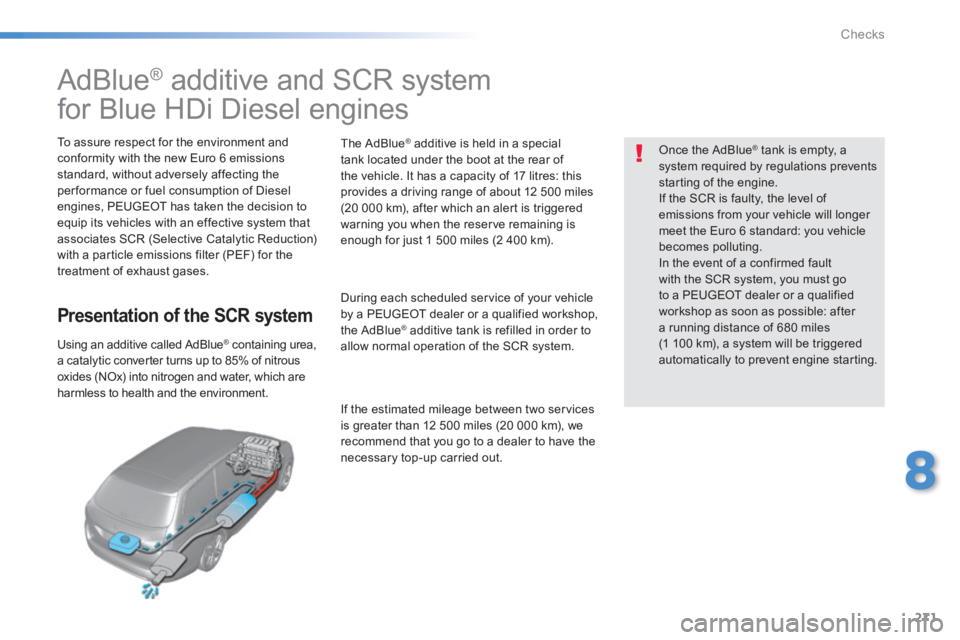
271
8
Checks
308_EN_CHAP08_VERIFICATIONS_ED02-2013
AdBlue ® additive and SCR system
for Blue HDi Diesel engines
To assure respect for the environment and conformity with the new Euro 6 emissions standard, without adversely affecting the per formance or fuel consumption of Diesel engines, PEUGEOT has taken the decision to equip its vehicles with an effective system that associates SCR (Selective Catalytic Reduction) with a particle emissions filter (PEF) for the treatment of exhaust gases.
Presentation of the SCR system
Using an additive called AdBlue ® containing urea, ® containing urea, ®
a catalytic converter turns up to 85% of nitrous oxides (NOx) into nitrogen and water, which are harmless to health and the environment.
The AdBlue ® additive is held in a special ® additive is held in a special ®
tank located under the boot at the rear of the vehicle. It has a capacity of 17 litres: this provides a driving range of about 12 500 miles (20 000 km), after which an alert is triggered warning you when the reserve remaining is enough for just 1 500 miles (2 400 km).
During each scheduled service of your vehicle by a PEUGEOT dealer or a qualified workshop, the AdBlue ® additive tank is refilled in order to ® additive tank is refilled in order to ®
allow normal operation of the SCR system.
If the estimated mileage between two services is greater than 12 500 miles (20 000 km), we recommend that you go to a dealer to have the necessary top-up carried out.
Once the AdBlue ® tank is empty, a ® tank is empty, a ®
system required by regulations prevents starting of the engine. If the SCR is faulty, the level of emissions from your vehicle will longer meet the Euro 6 standard: you vehicle becomes polluting. In the event of a confirmed fault with the SCR system, you must go to a PEUGEOT dealer or a qualified workshop as soon as possible: after a running distance of 680 miles (1 100 km), a system will be triggered automatically to prevent engine starting.
Page 289 of 400

287
9
Technical data
308_EN_CHAP09_CARACTERISTIQUES TECHNIQUES_ED02-2013
Identifi cation markings Various visible markings for the identification of your vehicle.
A. Vehicle Identification Number (VIN) under the bonnet. This number is engraved on the chassis near the right hand front wheel arch.
The tyre pressures must be checked when the tyres are cold, at least once a month.
If the tyre pressures are too low, this
increases fuel consumption.
B. Vehicle Identification Number (VIN) on the windscreen lower cross member. This number is indicated on a self-adhesive label which is visible through the windscreen.
C. Manufacturer's label. This self-destroying label affixed to the centre pillar, right or left hand side, contains the following information. - the manufacturer's name, - the European whole vehicle type approval number, - the vehicle identification number (VIN), - the maximum authorised weight (gross vehicle weight), - the maximum authorised weight with trailer (gross train weight), - the maximum front axle weight, - the maximum rear axle weight.
D. Tyre/paint label. This label, affixed to the centre pillar, on the driver's side, contains the following information. - the tyre inflation pressures with and without load, - the tyre sizes (including the tyre load index and speed rating), - the inflation pressure for the spare wheel, - the paint colour code.
Page 341 of 400
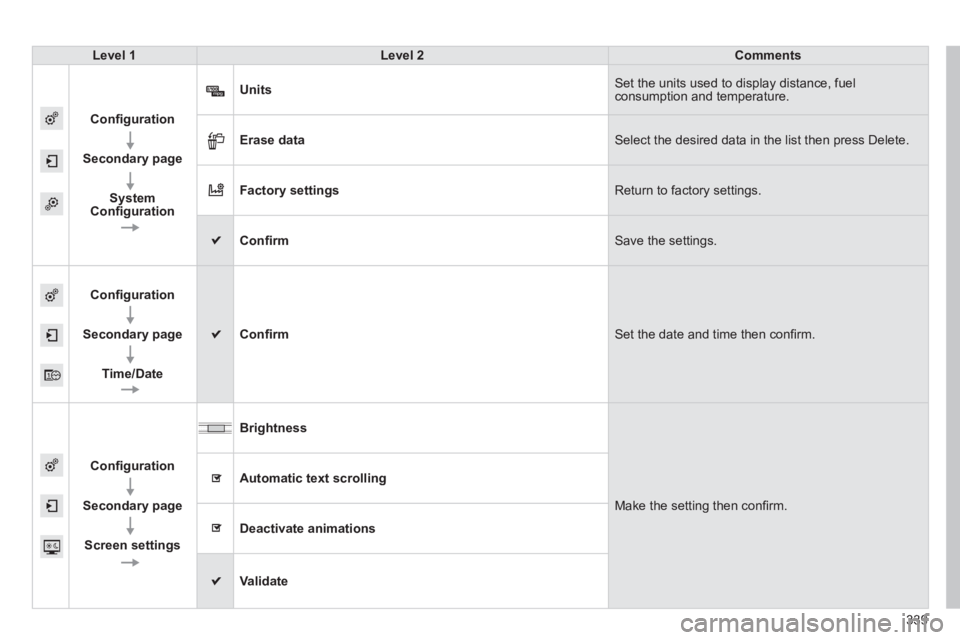
339
308_EN_CHAP10C_SMEGPLUS_ED02-2013
Level 1Level 2Comments
Confi guration
Secondary page
SystemConfi guration
Units Set the units used to display distance, fuel consumption and temperature.
Erase data Select the desired data in the list then press Delete.
Factory settings Return to factory settings.
Confi rm Save the settings.
Confi guration
Secondary page
Time/Date
Confi rm Set the date and time then confi rm.
Confi guration
Secondary page
Screen settings
Brightness
Make the setting then confi rm.
Automatic text scrolling
Deactivate animations
Validate
Page 346 of 400
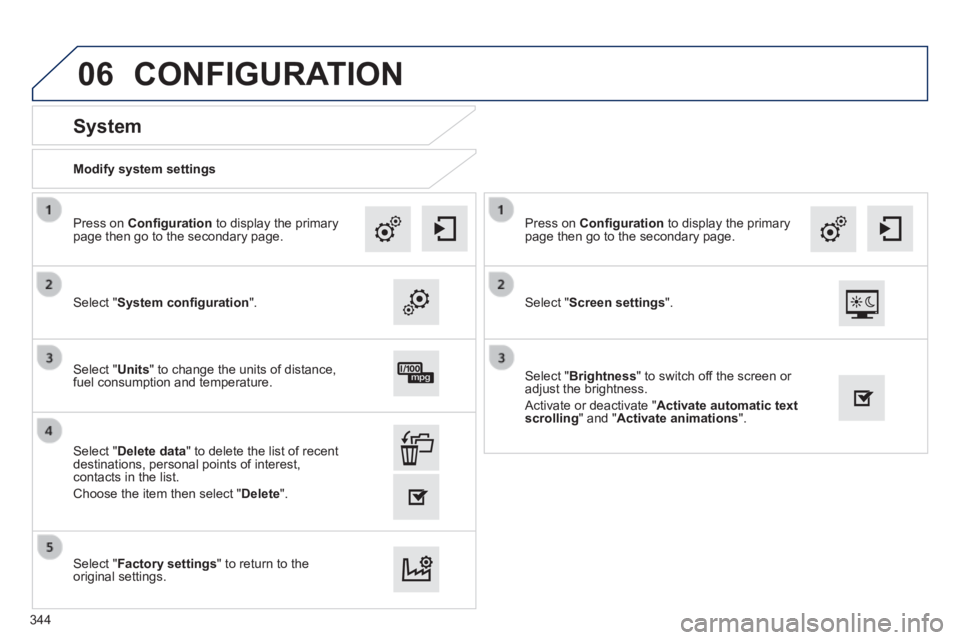
06
308_EN_CHAP10C_SMEGPLUS_ED02-2013
Modify system settings
System
Select " System confi guration ".
Press on Confi guration to display the primary page then go to the secondary page.
Select " Units " to change the units of distance, fuel consumption and temperature.
Select " Factory settings " to return to the original settings.
Select " Delete data " to delete the list of recent destinations, personal points of interest, contacts in the list.
Choose the item then select " Delete ".
CONFIGURATION
Select " Screen settings ".
Press on Confi guration to display the primary page then go to the secondary page.
Select " Brightness " to switch off the screen or adjust the brightness.
Activate or deactivate " Activate automatic text scrolling " and " Activate animations ".
344
Page 390 of 400
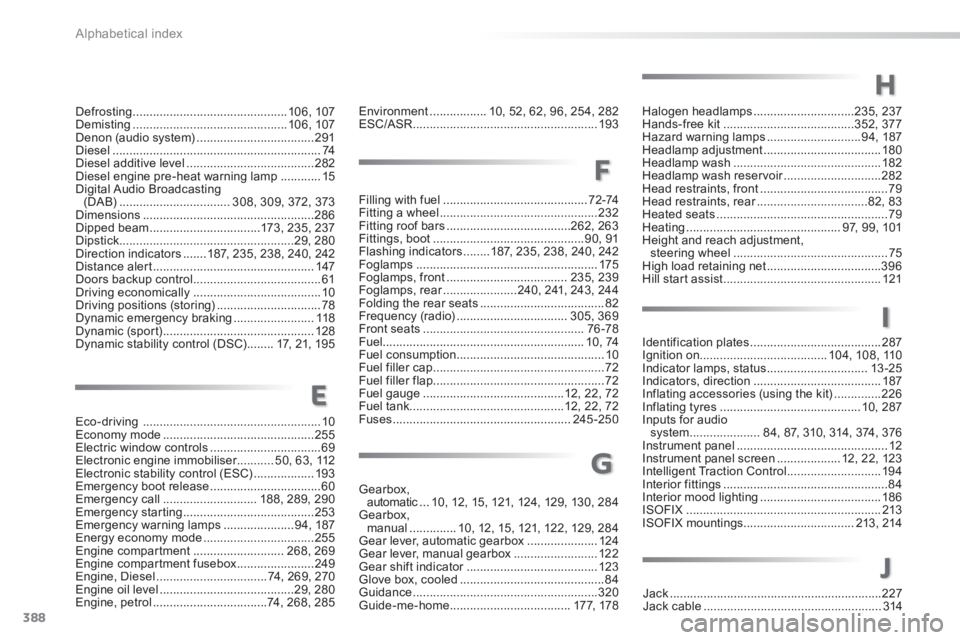
388
Alphabetical index
308_EN_CHAP11_INDEX ALPHA _ED02-2013
Filling with fuel ...........................................7 2 -74Fitting a wheel ...............................................232Fitting roof bars .....................................262, 263Fittings, boot .............................................90, 91Flashing indicators ........187, 235, 238, 240, 242Foglamps ......................................................175Foglamps, front ....................................235, 239Foglamps, rear ......................Foglamps, rear ......................Foglamps, rear240, 241, 243, 244Folding the rear seats .....................................82Frequency (radio) .................................305, 369Front seats ................................................76 -78Fuel............................................................10 , 74Fuel consumption ............................................10Fuel filler cap ...................................................72Fuel filler flap ...................................................72Fuel gauge ..........................................12, 22, 72Fuel tank..............................................12, 22, 72Fuses .....................................................245 -250
Gearbox, automatic ...automatic ...automatic10, 12, 15, 121, 124, 129, 130, 284Gearbox, manual ..............10, 12, 15, 121, 122, 129, 284Gear lever, automatic gearbox .....................124Gear lever, manual gearbox .........................12 2Gear shift indicator .......................................Gear shift indicator .......................................Gear shift indicator123Glove box, cooled ...........................................84Guidance .......................................................320Guide-me-home ....................................17 7, 178Jack ...............................................................227Jack cable .....................................................314
Identification plates .......................................287Ignition on......................................104, 108, 110Indicator lamps, status ..............................13 -25Indicators, direction ......................................187Inflating accessories (using the kit) ..............226Inflating tyres ..........................................10, 287Inputs for audio system .....................84, 87, 310, 314, 374, 376Instrument panel .............................................12Instrument panel screen ...................12, 2 2, 123Intelligent Traction Control ............................19 4Interior fittings .................................................84Interior mood lighting ....................................18 6ISOFIX ..........................................................213ISOFIX mountings.................................213, 214
Halogen headlamps ..............................235, 237Hands-free kit .......................................352, 377Hazard warning lamps ............................94, 187Headlamp adjustment ...................................180Headlamp wash ............................................182Headlamp wash reservoir .............................Headlamp wash reservoir .............................Headlamp wash reservoir282Head restraints, front ......................................79Head restraints, rear .................................Head restraints, rear .................................Head restraints, rear82, 83Heated seats ...................................................79Heating ..............................................97, 99, 101Height and reach adjustment, steering wheel ..............................................75High load retaining net ..................................396Hill start assist ...............................................121
F
G
J
I
H
Eco-driving .....................................................10Economy mode .............................................255Electric window controls .................................69Electronic engine immobiliser...........50, 63, 112Electronic stability control (ESC) ..................193Emergency boot release .................................60Emergency call ............................188, 289, 290Emergency starting .......................................253Emergency warning lamps .....................94, 187Energy economy mode .................................255Engine compartment ...........................268, 269Engine compartment fusebox .......................249Engine, Diesel .................................74, 269, 270Engine oil level ........................................29, 280Engine, petrol ..................................74, 268, 285
Defrosting ..............................................10 6, 107Demisting ..............................................10 6, 107Denon (audio system) ...................................291Diesel ..............................................................74Diesel additive level ......................................282Diesel engine pre-heat warning lamp ............15Digital Audio Broadcasting (DA B) .................................308, 309, 372, 373Dimensions ...................................................286Dipped beam .................................173, 235, 237Dipstick ....................................................29, 280Direction indicators .......187, 235, 238, 240, 242Distance alert ................................................147Doors backup control ......................................61Driving economically ......................................10Driving positions (storing) ...............................78Dynamic emergency braking ........................118Dynamic (sport) .............................................128Dynamic stability control (DSC) ........17, 21, 195
E
Environment .................10, 52, 62, 96, 254, 282ESC/ASR .......................................................193